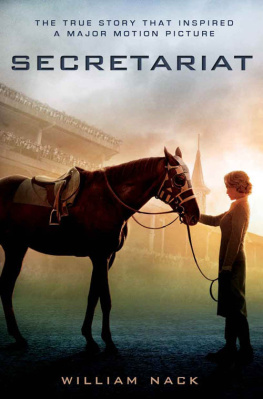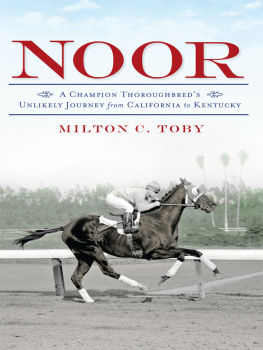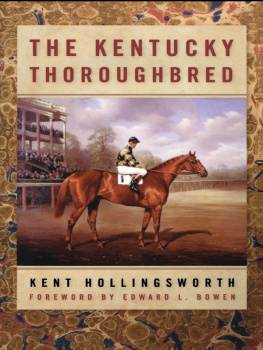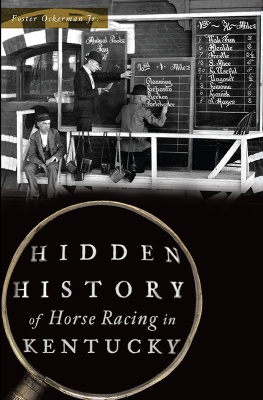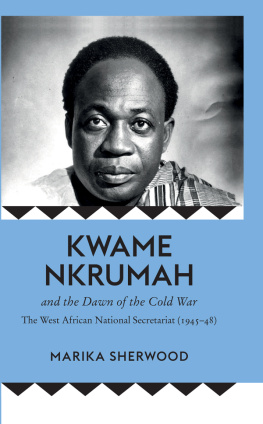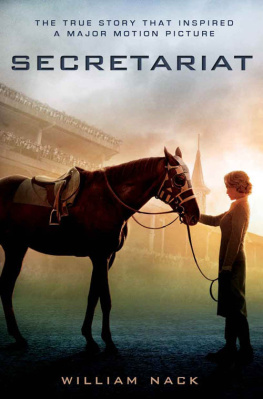Nack - Secretariat
Here you can read online Nack - Secretariat full text of the book (entire story) in english for free. Download pdf and epub, get meaning, cover and reviews about this ebook. City: New York;United States, year: 2010, publisher: Hyperion, genre: Non-fiction. Description of the work, (preface) as well as reviews are available. Best literature library LitArk.com created for fans of good reading and offers a wide selection of genres:
Romance novel
Science fiction
Adventure
Detective
Science
History
Home and family
Prose
Art
Politics
Computer
Non-fiction
Religion
Business
Children
Humor
Choose a favorite category and find really read worthwhile books. Enjoy immersion in the world of imagination, feel the emotions of the characters or learn something new for yourself, make an fascinating discovery.
- Book:Secretariat
- Author:
- Publisher:Hyperion
- Genre:
- Year:2010
- City:New York;United States
- Rating:3 / 5
- Favourites:Add to favourites
- Your mark:
- 60
- 1
- 2
- 3
- 4
- 5
Secretariat: summary, description and annotation
We offer to read an annotation, description, summary or preface (depends on what the author of the book "Secretariat" wrote himself). If you haven't found the necessary information about the book — write in the comments, we will try to find it.
Secretariat — read online for free the complete book (whole text) full work
Below is the text of the book, divided by pages. System saving the place of the last page read, allows you to conveniently read the book "Secretariat" online for free, without having to search again every time where you left off. Put a bookmark, and you can go to the page where you finished reading at any time.
Font size:
Interval:
Bookmark:
To my parents
and to Carolyne
Nearly forty years have passed since Secretariat swept to three record-smashing victories in the Triple Crownan unprecedented tour de force that confirmed him as the most capable and charismatic racehorse in the modern annals of the turfand today his legend as a Thoroughbred, with all that word implies, remains as vibrant and secure as ever.
Horsemen have always been loath to compare horses from different eras, seeing any attempt to do so as a diverting but futile exercise. Could Secretariat have beaten Man o War or Citation? Could either of them have whipped Swaps, Seattle Slew, or Native Dancer? Or run down the immortal Count Fleet or Dr. Fager? Or out-gutted Seabiscuit at his match-race best? To all such facile questions, of course, there are only facile answers. The only thing that is really certain, after the passage of two decades since his death at Claiborne Farm, is that Secretariat continues to be viewed as the modern standard against which all members of his tribe are judged.
His only point of reference is himself, turfwriter Charles Hatton wrote after witnessing the colts thirty-one-length victory in the Belmont Stakes.
If anything, time has only enriched and embellished his name. On ESPNs acclaimed TV series portraying the fifty greatest athletes of the twentieth century, he was ranked thirty-fifth, the only quadruped honored in the series. In another end-of-the-century event celebrating the decade of the 1970s, the U.S. Postal Service put his comely mug on a thirty-three-cent postage stamp. A three-quarter-sized bronze statue of Secretariat, commissioned by philanthropist Paul Mellon and depicting the horse in full flight, his head and forelegs thrust forward, decorates the middle of the walking ring at Belmont Parka symbolic centerpiece forever representing the best of the sport and the breed. And a full-sized statue in bronze, with jockey Ron Turcotte aboard and groom Ed Sweat trying to restrain the thoroughbred, was unveiled in 2006 at the Kentucky Horse Park in Lexingtonjust down the road from Claiborne Farm, where Secretariat died at age nineteen, on October 4, 1989, and where a loyal network of old friends, many of them anonymous, have kept his grave in flowers through the years, a symbolic reminder of the hold he has had on the memories of those who saw him run almost four decades before.
It was there at Claiborne, one early afternoon in 2009, that actress Diane Lane visited the storied horse cemetery behind the office, its rows of gray headstones engraved with names long celebrated in the richer histories of the American turf: Bold Ruler... Round Table... Gallant Fox... Damascus... Buckpasser... Mr. Prospector... and Secretariat. As she left through the cemetery gate, a gray-haired gent in a black windbreaker stopped behind her and bent over Secretariats grave, plucking a single red rose from a vase of flowers tipped against the headstone.
Here, the old gent said, handing the rose to Lane. The horse asked me to give this to you. Wanted you to have it.
Diane smiled, almost purring. Thank you, she said. Lifting the stem in both hands, she touched the rose like an artists brush to her exquisite face. I will treasure this, she said.
At the moment, the acclaimed actress was at the bustling center of the richest, most extravagant tribute ever paid to the life and legend of Secretariata full-length feature film starring Diane as Penny Chenery Tweedy, the woman who drove Secretariats career in place of her dying father (played by Scott Glenn), and the brilliant John Malkovich as trainer Lucien Laurin, the man with whom Penny shared the glories, the tumults, and the pressures that attended the leading of this magnificent chestnut, recently syndicated for $6 million, through the turbulent waters of the Triple Crown. I was down there, too, a hired hand observing the making of the film. Walt Disney Pictures, with Mayhem Pictures producing, had just begun shooting it at a rainy churchyard cemetery in rural Lexington, where the scene was the burial of Chenerys mother, Helen Bates Chenery, and where Diane perfectly evoked Pennys patrician reserve and grieving beauty beneath panoplies of black umbrellas.
It was, with Lane and Malkovich leading the way, a surpassing cast and crew. They all gathered later at Keeneland racecourse to film a reenactment of the scenes that unfolded at the 73 Belmont Stakes, the race regarded by most horsemen as the greatest performance ever by an American thoroughbred; among the familiar faces dressed for their parts were James Cromwell as breeder Ogden Phipps, Fred Thompson as Claiborne president Bull Hancock, and Nelsan Ellis as Sweat. Behind the camera was the peripatetic Dean Semler, whose cinematography in Dances with Wolves had won him an Oscar in 1990. Movie locations mimic the collapsible world of the traveling circus, moving from place to place, and after a week at old Keeneland, in the middle of the Blue Grass, the Secretariat troupe packed up and hauled its cameras and trailers seventy miles west to Louisville. Since 1875, the year of its inaugural running, River City had been home to the Kentucky Derby, with its signature Twin Spires, its massive clubhouse and grandstand, and its ancient vault of echoing sounds and memories.
Disney had acquired the rights to this book for the making of the movie, and the film company, at Mayhems urging, had retained me as the technical consultant on the film. For those who had been at Churchill Downs on May 5, 1973, it was impossible to wander those historic grounds and that movie set last yearamong throngs of extras dressed in the polyesters of the early 70s, amid fleets of old cars imported from the late 60s, and around the five attractive chestnuts wrangled from all over to play the horseand not recall that sublime magic of Derby week some thirty-six years before.
I can close my eyes and see the scenes unfolding one by one:
The morning of May 2, Thursday, two days before the witching hour, when a hand-wringing Lucien and Penny, still agonizing over Secretariats stunning defeat in the Wood Memorial eleven days before, sent him out for a last, crucial morning workout at the Downs. As the colt flew down that stretch, sizzling a final 220 yards in 0:11 / seconds, Turcottes blue and white jacket was billowing like a parachute on his back. Later, Sweat, a rub rag dangling from his back pocket, was whistling as he led Secretariat back to the barn and washed him off with soap and water, the colts golden coat shining wetly in the sun.
The late afternoon of May 5, Derby Day, when the backstretch silence was broken as the loudspeakers blared, Horsemen! Bring your horses to the paddock for the Derby! And there was Secretariat, Eddie leading him, walking around the clubhouse turn toward the paddock, the colts head bobbing, his mouth grinding on the bit, until he strode into the straightaway past the clubhouse seats, where thousands pressed forward to see him, and he stopped and raised his head and stared a few seconds at the mammoth stands and raucous crowds, still as a piece of statuary, before dropping his head and walking on.
At the top of the stretch at Churchill Downs at 5:38 p.m., the hour had come round at last: Secretariat was battling his arch rival, Sham, and they were nose and nose through the first 100 yards into the lane when Secretariat began to pull away, slowly but inexorably, and Sham began melting down the wick of that fiery pace as 130,000 people sent up a roar and Secretariat bounded home alone in 1:59 / the fastest Kentucky Derby ever runthe first horse ever to shade two minutes for the mile and a quarter. In the doing, he pulled off the unprecedented feat of running each successive quarter-mile split faster than the preceding one0:25 / , 0:24, 0:23 / , 0:23 / , and 0:23 flatliterally running faster and faster as the race went on.
Next pageFont size:
Interval:
Bookmark:
Similar books «Secretariat»
Look at similar books to Secretariat. We have selected literature similar in name and meaning in the hope of providing readers with more options to find new, interesting, not yet read works.
Discussion, reviews of the book Secretariat and just readers' own opinions. Leave your comments, write what you think about the work, its meaning or the main characters. Specify what exactly you liked and what you didn't like, and why you think so.

